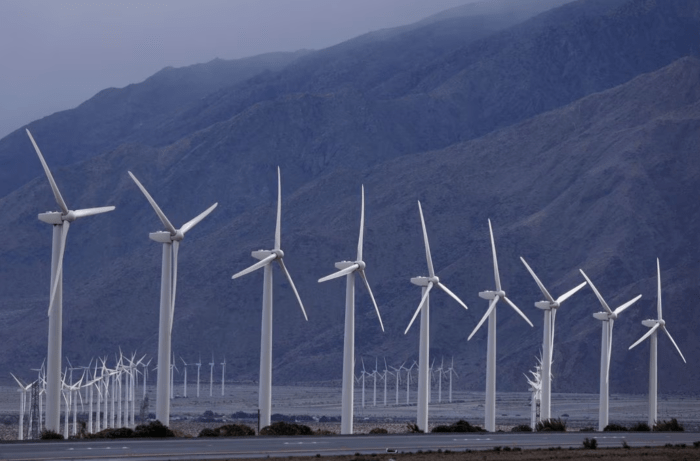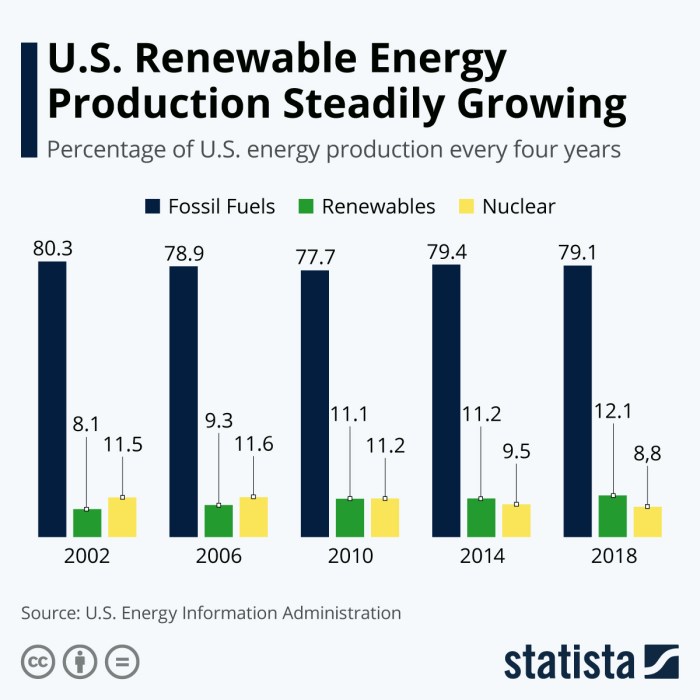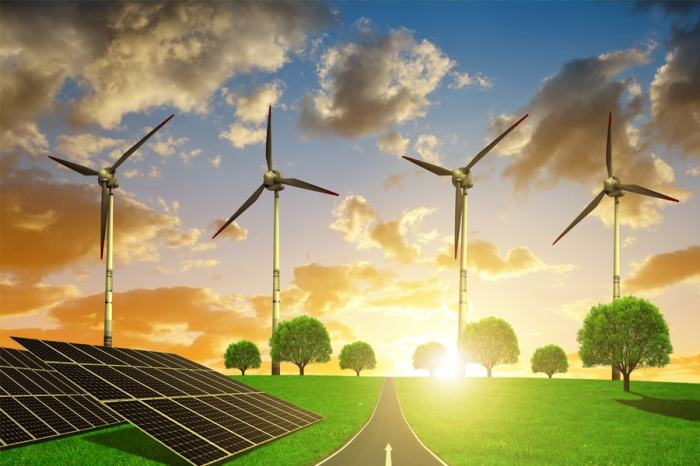Renewable Energy Projects in the US A Comprehensive Overview
Renewable energy projects in the US are experiencing a period of significant growth, driven by a confluence of factors including technological advancements, supportive government policies, and increasing public awareness of climate change. This exploration delves into the diverse landscape of renewable energy in the United States, examining the various types of projects, their geographic distribution, economic impacts, and the regulatory environment shaping their development.
We will also look towards the future, considering emerging technologies and innovative financing models that promise to further accelerate the transition to a cleaner energy future.
The United States boasts a diverse portfolio of renewable energy sources, each with its unique characteristics and challenges. From the vast solar farms of the Southwest to the wind farms dotting the Great Plains, the nation’s commitment to renewable energy is evident in its ambitious targets and substantial investments. Understanding the intricacies of these projects—from their environmental impacts to their economic benefits—is crucial for informed decision-making and responsible energy planning.
Types of Renewable Energy Projects in the US

Source: erisinfo.com
The United States boasts a diverse landscape of renewable energy projects, each contributing to the nation’s transition towards a cleaner energy future. These projects vary significantly in their technological underpinnings, geographical suitability, and environmental impacts. Understanding the nuances of each type is crucial for informed policymaking and investment decisions.
Overview of Major Renewable Energy Types in the US
The following table summarizes the major types of renewable energy projects prevalent in the US, highlighting their geographical distribution, current capacity, and growth potential. Note that precise figures for capacity and growth potential can fluctuate based on various factors including government policies and technological advancements. The data presented represents a snapshot in time and should be considered an approximation.
| Type | Geographic Distribution | Current Capacity (MW) (Approximate) | Growth Potential |
|---|---|---|---|
| Solar (Photovoltaic & Concentrated Solar Power) | Sunbelt states (California, Arizona, Nevada, Texas, Florida), but increasingly widespread across the country. | Over 150,000 | Very high; driven by decreasing costs, technological improvements, and supportive policies. Significant expansion expected in distributed generation (rooftop solar). |
| Wind | Midwest (Iowa, Kansas, Oklahoma, Texas), Great Plains, and coastal regions. | Over 150,000 | High; continued growth anticipated in onshore and offshore wind farms, particularly in areas with high wind speeds and suitable land/water resources. Technological advancements in turbine design are driving efficiency gains. |
| Hydropower | Primarily in the Pacific Northwest, Southeast, and mountainous regions. | Over 100,000 | Moderate; potential for expansion is limited by environmental concerns and available suitable sites. Focus is shifting towards modernization of existing dams and improving efficiency. |
| Geothermal | Concentrated in the Western US (California, Nevada, Utah) due to geological activity. | Over 3,000 | Moderate; growth is constrained by geographical limitations and the high upfront costs of development. Enhanced geothermal systems (EGS) offer potential for expansion into areas with less readily accessible geothermal resources. |
| Biomass | Distributed across the country, often utilizing agricultural residues and forestry byproducts. | Over 10,000 | Moderate; growth depends on factors such as sustainable sourcing of biomass feedstock and technological advancements in bioenergy conversion processes. |
Environmental Impacts of Renewable Energy Projects
Each renewable energy source presents a unique set of environmental impacts, both positive and negative. A holistic assessment is necessary to understand the overall sustainability of each technology.Solar energy, for instance, boasts a significantly low carbon footprint during operation, but manufacturing processes can involve energy-intensive steps and the disposal of solar panels poses challenges. Wind energy, while clean during operation, can impact avian and bat populations, necessitating careful site selection and mitigation strategies.
Hydropower, while providing a reliable source of energy, can alter river ecosystems and affect fish migration patterns. Geothermal energy generally has a low environmental impact, but can release small amounts of greenhouse gases during operation. Biomass energy can contribute to deforestation and air pollution if not managed sustainably. Careful planning and responsible development practices are essential to minimize negative impacts and maximize the environmental benefits of all renewable energy technologies.
Technological Advancements Driving Renewable Energy Growth
Significant technological advancements are propelling the growth of renewable energy across the board. In solar energy, the efficiency of photovoltaic cells has increased dramatically, while advancements in energy storage technologies are addressing the intermittency issue. Wind turbine designs are becoming larger and more efficient, capturing more energy from the wind. Hydropower is benefiting from improved turbine designs and smart grid integration.
Geothermal energy is seeing progress in enhanced geothermal systems (EGS), which could unlock vast untapped resources. Biomass energy is seeing advancements in biofuel production and conversion technologies, improving efficiency and reducing emissions. These technological leaps, combined with supportive policies and decreasing costs, are paving the way for a wider adoption of renewable energy sources in the US.
Geographic Distribution of Renewable Energy Projects: Renewable Energy Projects In The US
The geographic distribution of renewable energy projects across the United States is far from uniform, reflecting a complex interplay of resource availability, regulatory frameworks, and economic factors. Certain regions boast a concentration of specific renewable energy sources due to their unique geographical and climatic characteristics. Understanding this distribution is crucial for effective planning and policy-making within the renewable energy sector.
A hypothetical map illustrating this distribution would show a strong concentration of solar energy projects in the Southwest (Arizona, Nevada, California, and New Mexico), characterized by high solar irradiance and ample desert land. The Midwest and Great Plains states, including Iowa, Kansas, and Illinois, would exhibit significant wind energy development, reflecting consistent and strong wind patterns. Hydropower projects would be concentrated in the Pacific Northwest (Washington, Oregon, Idaho), along the Appalachian Mountains, and in other areas with substantial river systems.
Finally, geothermal energy projects would be primarily located in the West, notably in California and Nevada, leveraging the region’s geothermal resources.
Factors Influencing Project Location
Several key factors determine the location of renewable energy projects. Resource availability is paramount; solar farms require high solar irradiance, wind farms need consistent strong winds, and hydropower necessitates substantial water flow. Land use regulations significantly influence project siting, with some areas designated as protected lands, limiting development. Furthermore, the proximity to existing grid infrastructure is critical for efficient energy transmission, as connecting remote projects to the grid can be costly and complex.
Finally, economic considerations, including land costs, labor costs, and access to financing, also play a crucial role in project location decisions.
Challenges in Siting Renewable Energy Projects
The siting of renewable energy projects is not without its challenges. Environmental concerns, such as habitat disruption and impacts on wildlife, often arise, particularly with large-scale projects. Community opposition can also hinder project development, stemming from concerns about visual impacts, noise pollution, and potential effects on property values. For example, the construction of large wind farms has faced resistance in some communities due to concerns about noise and the visual impact on landscapes.
In addition, navigating complex permitting processes and securing necessary approvals can pose significant delays and hurdles. The inherent variability of renewable resources, such as the intermittent nature of solar and wind power, also presents challenges for grid integration and reliable power supply. For instance, periods of low solar irradiance or wind speed require backup power sources or sophisticated energy storage solutions, adding to the complexity and cost of renewable energy projects.
Economic Impacts of Renewable Energy Projects
The transition to renewable energy sources in the United States offers significant economic advantages beyond environmental benefits. These impacts span various sectors, from manufacturing and installation to long-term cost savings and the creation of a more resilient energy infrastructure. A comprehensive understanding of these economic effects is crucial for policymakers and investors alike.
Job Creation and Economic Benefits Across Sectors
Renewable energy projects generate substantial employment opportunities across numerous sectors. The economic benefits extend beyond direct job creation, stimulating related industries and boosting local economies.
- Manufacturing: The production of solar panels, wind turbines, and other renewable energy technologies fuels a robust manufacturing sector, creating jobs in factories and supporting industries.
- Installation and Construction: The installation of renewable energy systems, such as solar farms and wind power plants, requires a large workforce of skilled laborers, electricians, and construction workers.
- Operation and Maintenance: Ongoing maintenance and operation of renewable energy facilities provide long-term employment opportunities for technicians and engineers.
- Research and Development: Continuous innovation in renewable energy technologies necessitates a strong research and development sector, creating jobs for scientists, engineers, and researchers.
- Supply Chain: The entire supply chain, from raw material extraction to component manufacturing and transportation, benefits from the growth of the renewable energy sector, generating jobs across various stages.
Financial Incentives and Government Policies
The US government employs various financial incentives and policies to encourage the development and adoption of renewable energy. These measures play a vital role in making renewable energy projects economically viable and competitive with fossil fuels.
- Tax Credits: The Investment Tax Credit (ITC) and Production Tax Credit (PTC) offer significant tax reductions for renewable energy projects, reducing the upfront capital costs and making them more attractive to investors.
- Grants and Loans: Government grants and loan programs provide financial assistance to renewable energy developers, reducing financial risks and facilitating project development.
- Renewable Portfolio Standards (RPS): Many states have implemented RPS, requiring a certain percentage of electricity generation to come from renewable sources. This policy creates a guaranteed market for renewable energy, incentivizing investment.
- Feed-in Tariffs (FITs): Some states offer FITs, guaranteeing a fixed price for renewable energy produced, providing price certainty and attracting investment.
- Green Bonds: The issuance of green bonds allows governments and corporations to raise capital specifically for renewable energy projects, fostering increased investment in the sector.
Long-Term Economic Sustainability and Cost-Effectiveness
While the initial investment in renewable energy projects can be significant, the long-term economic sustainability and cost-effectiveness are increasingly compelling compared to fossil fuels.
The decreasing costs of renewable energy technologies, coupled with rising fossil fuel prices and the environmental costs associated with fossil fuel extraction and combustion, make renewable energy a more economically viable option over the long term. For example, the cost of solar and wind power has fallen dramatically in recent years, making them competitive with, and in many cases cheaper than, traditional energy sources.
This trend is expected to continue, further solidifying the economic viability of renewable energy. Furthermore, the long-term operational costs of renewable energy systems are generally lower than those of fossil fuel-based power plants, reducing ongoing expenses and ensuring long-term economic sustainability.
Policy and Regulatory Landscape

Source: statcdn.com
The development and deployment of renewable energy projects in the United States are significantly shaped by a complex interplay of federal and state-level policies and regulations. These frameworks influence everything from project financing and permitting to grid interconnection and market access. Understanding this landscape is crucial for both renewable energy developers and policymakers.The regulatory environment, while aiming to promote renewable energy, also presents significant challenges for developers.
Navigating these complexities requires careful planning, strategic partnerships, and a thorough understanding of applicable laws and regulations. This section examines the key aspects of this policy and regulatory landscape, focusing on federal and state policies, regulatory hurdles, and the role of government incentives.
Key Federal and State-Level Policies
Federal and state governments employ a variety of policy tools to encourage renewable energy development. These policies have evolved over time, reflecting changing technological capabilities, economic conditions, and environmental priorities. The effectiveness of these policies is an ongoing subject of debate and analysis.
- Federal Production Tax Credit (PTC) and Investment Tax Credit (ITC): These tax credits provide significant financial incentives for the development of renewable energy projects, particularly wind and solar. The PTC offers a per-kilowatt-hour credit for electricity generated, while the ITC provides a credit based on the capital investment in the project. These credits have been instrumental in driving down the cost of renewable energy and increasing its deployment.
- Renewable Portfolio Standards (RPS): Many states have implemented RPS, which mandate that a certain percentage of electricity generation must come from renewable sources by a specific date. These policies create a guaranteed market for renewable energy, stimulating investment and development. The stringency of RPS varies considerably across states, reflecting differing policy priorities and resource availability.
- Federal Renewable Energy Tax Credits for Businesses: Several tax incentives, like Section 179 depreciation, enable businesses to deduct the cost of renewable energy equipment from their taxes, making it financially more attractive to invest in renewable energy. This can range from solar panels on a business’s roof to larger-scale wind farms.
- State-Level Incentives and Regulations: Beyond RPS, many states have implemented additional incentives, such as grants, tax exemptions, and streamlined permitting processes, to further promote renewable energy development within their borders. These state-level policies often complement or build upon federal initiatives.
Major Regulatory Hurdles for Renewable Energy Developers
Despite supportive policies, renewable energy developers face several regulatory challenges that can delay projects and increase costs. These hurdles highlight the need for streamlined and efficient regulatory processes.
- Permitting and Approvals: The permitting process for renewable energy projects can be lengthy and complex, involving multiple agencies and layers of review. This can lead to significant delays and uncertainty for developers. The permitting process often involves environmental impact assessments, land-use approvals, and interconnection studies with the power grid.
- Grid Interconnection: Connecting renewable energy projects to the electricity grid can be a major challenge, particularly for large-scale projects. This often requires upgrades to transmission infrastructure, which can be costly and time-consuming. Grid operators may have limitations on the amount of renewable energy they can integrate into the grid at any given time, leading to delays and potential rejection of projects.
- Land Use and Siting Restrictions: Finding suitable locations for renewable energy projects can be difficult due to land-use regulations, environmental concerns, and community opposition. Balancing the need for renewable energy development with other land-use priorities is a significant challenge.
- Environmental Regulations: While renewable energy is generally considered environmentally friendly, projects still need to comply with various environmental regulations related to wildlife habitat, water resources, and air quality. These regulations can add complexity and cost to project development.
Government Subsidies and Tax Credits in Promoting Renewable Energy Adoption
Government subsidies and tax credits play a pivotal role in making renewable energy projects financially viable. These incentives bridge the gap between the cost of renewable energy and the market price of electricity, accelerating the transition to cleaner energy sources. Without these subsidies, the deployment of renewable energy would be significantly slower and more limited.
For example, the significant drop in the cost of solar photovoltaic (PV) technology over the past decade is partly attributable to the sustained support provided by the ITC. This has allowed solar power to compete more effectively with fossil fuels in many markets. Similarly, the PTC has been crucial in fostering the growth of the wind energy sector. The continued availability and potential expansion of these incentives are vital for maintaining the momentum of renewable energy adoption in the US.
Technological Innovations and Future Trends
The rapid advancement of renewable energy technologies is driving a significant shift in the US energy landscape. Emerging innovations are not only improving the efficiency and affordability of existing renewable energy sources but also opening up new possibilities for sustainable energy generation and storage. This section will explore some key technological advancements and their projected impact on the future of renewable energy in the US.
Several factors are contributing to the projected growth of renewable energy, including technological breakthroughs that are making renewable energy more cost-competitive, supportive government policies designed to incentivize renewable energy adoption, and a growing consumer and business demand for cleaner energy sources. The interplay of these elements is creating a dynamic and rapidly evolving sector.
Emerging Renewable Energy Technologies
The following table summarizes some of the most promising emerging technologies in renewable energy, highlighting their advantages and challenges.
| Technology | Description | Advantages | Challenges |
|---|---|---|---|
| Advanced Solar Panels (Perovskite, Tandem Cells) | These next-generation solar cells utilize different materials and structures to achieve higher efficiencies than traditional silicon-based panels. Perovskites offer potentially lower manufacturing costs, while tandem cells combine different materials to capture a wider range of the solar spectrum. | Higher energy conversion efficiency, potentially lower manufacturing costs, improved performance in low-light conditions. | Long-term stability concerns for perovskites, higher initial costs for some advanced technologies, scaling up manufacturing to meet demand. |
| Next-Generation Wind Turbines | Larger rotor diameters, taller towers, and advanced blade designs are leading to significant increases in wind turbine capacity and efficiency. Floating offshore wind turbines are also expanding access to high-wind resources. | Increased energy generation per turbine, reduced cost per kilowatt-hour, access to previously untapped offshore wind resources. | Higher initial capital costs, environmental impacts of construction and operation (e.g., bird and bat mortality), challenges in siting and permitting, grid integration complexities. |
| Advanced Energy Storage Solutions | Beyond traditional pumped hydro, technologies like lithium-ion batteries, flow batteries, and compressed air energy storage are improving in terms of capacity, lifespan, and cost-effectiveness, enabling better grid integration of renewable energy. | Improved grid stability, enhanced reliability of renewable energy supply, enabling greater penetration of intermittent renewable sources (solar and wind). | High initial costs for some technologies, limited lifespan for some battery technologies, environmental concerns related to battery manufacturing and disposal, scalability challenges. |
Projected Growth of Renewable Energy in the US, Renewable energy projects in the US
The future growth of renewable energy in the US is expected to be substantial, driven by a confluence of technological advancements, supportive policies, and market forces. For example, the Inflation Reduction Act of 2022 provides significant tax credits and incentives for renewable energy projects, accelerating deployment. The increasing cost-competitiveness of renewable energy, particularly solar and wind, is also a major driver.
While precise projections vary depending on the specific assumptions made, many analysts predict a significant increase in renewable energy’s share of the US electricity generation mix over the next decade, with some scenarios envisioning a doubling or tripling of current capacity.
For instance, the U.S. Energy Information Administration (EIA) projects that renewable energy sources (excluding hydropower) will account for over 40% of U.S. electricity generation by 2050. This projection is influenced by factors like the continued decline in renewable energy costs, ongoing technological improvements, and the increasing policy support. However, it’s important to note that these projections are subject to change based on various economic, technological, and policy factors.
Innovative Financing Models and Partnerships
The expansion of renewable energy in the US is being facilitated by a variety of innovative financing models and partnerships. These approaches are crucial for overcoming the often high upfront capital costs associated with renewable energy projects.
Examples include Power Purchase Agreements (PPAs), where businesses or utilities purchase the electricity generated by a renewable energy project without owning the project itself, reducing their upfront investment risk. Green bonds, which are debt instruments used to finance environmentally friendly projects, have also become increasingly popular, attracting investment from both institutional and individual investors. Public-private partnerships are another significant mechanism, combining the resources and expertise of government entities with the private sector to develop and implement large-scale renewable energy projects.
The California Public Utilities Commission’s support for community solar projects, allowing multiple customers to share the benefits of a single solar installation, serves as a good example of a successful public-private partnership driving renewable energy adoption.
Final Wrap-Up

Source: cmu.edu
The future of renewable energy in the US appears bright, propelled by technological innovation, supportive policy frameworks, and a growing recognition of the urgency to combat climate change. While challenges remain, including grid integration issues and the need for consistent policy support, the continued growth of renewable energy projects promises significant economic benefits, job creation, and a substantial reduction in greenhouse gas emissions.
Further investment in research and development, along with effective collaboration between government, industry, and communities, will be essential to unlock the full potential of renewable energy and pave the way for a sustainable energy future.
FAQs
What are the biggest challenges facing renewable energy development in the US?
Major challenges include intermittency of renewable sources (sun and wind), grid infrastructure limitations to handle fluctuating power supply, securing necessary land and permits, and navigating complex regulatory processes.
How does the US compare to other countries in renewable energy adoption?
The US is a major player in renewable energy, but its adoption rate varies by state and technology. Compared to some European nations, the US has a higher overall energy consumption, leading to a larger absolute but potentially smaller relative shift towards renewables.
What role do energy storage technologies play in the future of renewable energy in the US?
Energy storage is critical for addressing the intermittency of solar and wind power. Technologies like batteries, pumped hydro, and compressed air energy storage are vital for ensuring a reliable and consistent energy supply from renewables.
What are some examples of innovative financing models for renewable energy projects?
Innovative financing includes Power Purchase Agreements (PPAs), where buyers purchase the electricity generated, and green bonds, which are debt instruments specifically issued to finance environmentally friendly projects.









